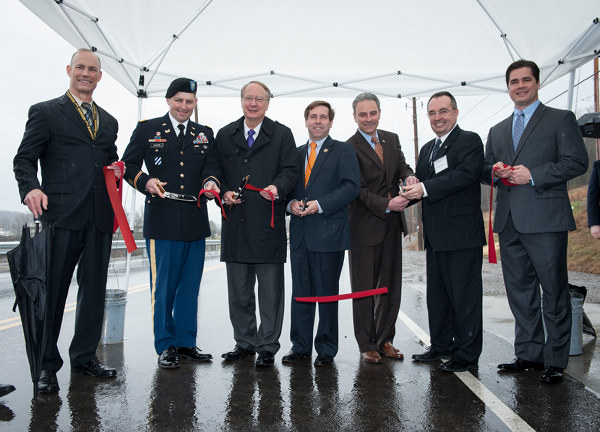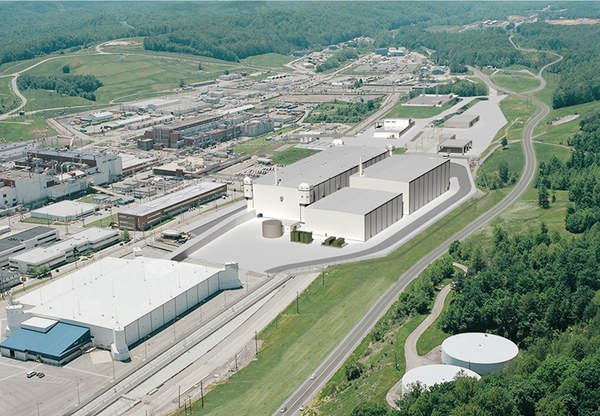
Pictured above is the new Bear Creek Road extension and bridge on the west side of the Y-12 National Security Complex.
They called it their first major milestone: the completion of site readiness work, delivered on time and under budget. The work included the relocation of Bear Creek Road, a new bridge, and construction of a haul road.
It’s part of the project to build a Uranium Processing Facility at the Y-12 National Security Complex. UPF could replace World War II-era buildings at Y-12. The project has been capped at $6.5 billion, and it’s expected to be completed by 2025.
Federal officials and contractors celebrated the completion of the site readiness subproject in a Friday morning ceremony at Y-12.
“The completion of this project is a significant achievement,” said Frank Klotz, administrator of the National Nuclear Security Administration, a semi-autonomous agency within the U.S. Department of Energy. Y-12 is an NNSA site.
UPF is DOE’s single largest capital investment in Tennessee since World War II and NNSA’s largest-ever construction project. UPF will replace the hub of the nation’s uranium processing operations. Klotz said it will help Y-12 move key uranium enrichment operations out of the aging Building 9212 facilities by 2025 and modernize and “rightsize” those operations.
“UPF is essential to our nation’s uranium mission,” said John Eschenberg, UPF Federal Project director. “Site readiness work sets the standard for UPF and opens the door for other site infrastructure projects to begin. We’ve accomplished a lot of work in an area that stretches across approximately a five-mile linear footprint. Most importantly, we have accomplished all of these activities securely, on schedule, under budget, and with high quality.”
The NNSA said the site readiness construction subproject, which includes the Bear Creek Road extension and the creation of the haul road, began in late spring 2013. A previous section of Bear Creek Road will become the haul road, and it will be used to segregate earthmoving equipment from plant traffic and alleviate traffic congestion while the UPF project is under construction.
Besides that road, the bridge, and the relocation of Bear Creek Road, the site readiness subproject also included the relocation of several potable water lines; rerouting of overhead electrical lines; mitigation for wetlands affected by road construction; development of the west borrow and wet spoils areas to receive soils for later project phases; demolition of a parking lot, guard tower, and other structures; and construction of sediment basins to protect the facilities natural resources from erosion and sedimentation.
“The represents…a landmark day for us,” Eschenberg said.
Much of the work, which contributes to reducing the site’s “nuclear footprint,” was underground.
Klotz said a significant portion of the work was done under small business contracts, including with Avisco of Oak Ridge.
The NNSA said the site readiness work supports the start of site infrastructure and services work, which will include the demolition of an existing building (an old training building), hillside excavation, construction of a sediment basin, installation of a vehicle arresting system gate, construction of a new portal, establishment of a concrete batch plant, and building the construction support facility.
U.S. Representative Chuck Fleischmann, a Tennessee Republican whose district includes Oak Ridge, said the UPF project has six key components, or subprojects. The first three are less critical and the last three are more complex and critical. Klotz said the last three deal with nuclear facilities.
Eschenberg said the last three steps include a mechanical and engineering building, a salvage and accountability building, and a main processing building.

From left to right are
Don Peters, Uranium Processing Facility Project Office; Lt. Col. John Hudson, commander of the Nashville District U.S. Army Corps of Engineers; NNSA Administrator General Frank Klotz; Congressman Chuck Fleischmann; UPF Federal Project Director John Eschenberg; UPF Project Director Brian Reilly; and Eric Thompson, UPO. (Photo courtesy NNSA)
That approach is a change from the earlier one-building approach, Klotz said. The change was a result of the so-called Red Team review led about a year ago by Oak Ridge National Laboratory Thom Mason. The idea is to segregate work by its hazard and security challenges, recognizing that the cost per square foot can vary.
UPF design work continues, and federal officials expect it to be 90 percent complete by Fiscal Year 2017, Klotz said. UPF construction won’t start until the design is 90 percent complete, and the baseline cost won’t be set until then.
UPF Project Director Brian Reilly said the UPF team has demonstrated, during this first phase, an “exceptional commitment to the fundamental principles of any successful construction project: safety, high quality, cost, and schedule.
“During the last year, we have really changed the landscape on the west end of the Y-12 complex, and we have done this work safely for more than 600 days without a recordable accident or injury,” Reilly said.
To execute the work, the NNSA said it employed an integrated acquisition and project management strategy to “ensure best use of taxpayer dollars.” This strategy includes a partnership between DOE, the U.S. Army Corps of Engineers, and Consolidated Nuclear Security LLC, which manages and operates Y-12 for the NNSA.
“Our unique partnerships have served us well by capitalizing on the core competencies of each agency and contractor,” said Lieutenant Colonel John Hudson, commander of the USACE Nashville District. “At the same time, the multiple interfaces require clear and continuous communication, keen attention to detail, and active collaboration among all team members. The cooperation between all parties has been exceptional.”
“UPF will be the core of our nation’s nuclear security operations for many decades,” added Eschenberg. “Delivering this facility is crucial for our community and for our country. Site readiness is the first step in completing the project, and we will continue to build on this success for future stages of the project.”
More information will be added as it becomes available.

Leave a Reply